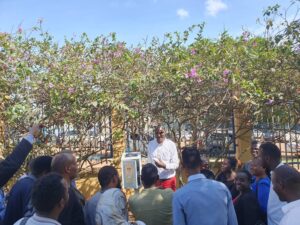
As a public utility fully owned by the government, the National Water and Sewerage Corporation (NWSC) has grown tremendously over the last five years in regard to Billing, revenue, customer base, and geographical coverage. Currently serving over 18,000,000 Ugandans in 273 towns across the country with annual revenue of over USD 138 million.
Several factors have contributed to this business growth, however, core to this has been the continuous and deliberate engagement with her stakeholders. NWSC directs all its operations and engagements tagged on the catchphrase “Water for All, for a delighted customer by a motivated workforce”. This catchphrase emphasizes the core business of the utility which is, the provision of water to all Ugandans while maintaining a cordial and mutual relationship with the customer (external stakeholders) reinforced by a motivated and supportive staff (internal stakeholders).
Management at NWSC has over the last 10 years realized immense benefits in working closely with stakeholders and as such revised her Mission statement to read “To sustainably and equitably provide cost-effective, quality water and sewerage services while conserving the environment and enhancing stakeholder trust.”
It is common logic that “you cannot milk an unhappy cow”. Customers should ideally be happy in order to guarantee high levels of willingness to pay for services. NWSC stakeholder engagement and interaction is being carried out through various channels which include;
- Water Barazas’: Baraza is a Swahili word meaning a place where public meetings are held. The water barazas are customer interactions between NWSC and the public. The spirit of these barazas is to publicly account to local leadership and communities at large through regular stakeholder meetings. The Baraza has provided a platform for social interaction with customers that has eventually helped to impact the design of strategic and tactical plans for improved service delivery.
- Water Community Communication (WACOCO) Clubs: These clubs were established to bridge and strengthen the gap between the corporation and various grassroots civic and community groups to address the localized challenges, needs, and expectations of consumers. During such WACOCO meetings, there is an emphasis put on the elements that are necessary to ensure cost-effective operations and capital investments.
- School Water and Sanitation (SWAS) Clubs: SWAS clubs are a novel initiative that targets interaction with school-going children who are a critical segment of Uganda’s population. Through the SWAS Clubs, the Corporation is engaging the younger generation through creative and innovative approaches with the aim of imparting knowledge on water and sanitation to the next generation
- Know your Customer (KYC) Approach: The modern business trend is to continuously engage customers as customer needs change very fast and require resilient approaches to cope. As such, NWSC has adopted the KYC approach where Individual NWSC staff have taken up the role of sensitizing and providing required services to customers within a specific service area when needed.
- High-level stakeholder meetings: For any public entity there are stakeholders that are in charge of very influential constituencies that are crucial for smooth operations. These include members of parliament, judicial officers, elected political leaders, religious leaders, development partners, collaborating institutions, the media, manufacturers, etc. Regular meetings are held with the different stakeholder groups to communicate the Corporation’s strategies and service delivery programs. In turn, from an informed point of view, the stakeholder groups provide the necessary support for these strategies and programs.
- Regular media engagements: The regular media engagements have allowed NWSC to share up-to-date project and service delivery information. This has discouraged miscommunication of NWSC service delivery programs but has also presented a platform through which the corporation reaches out and communicates to the country at large.
At NWSC, the corporation is aware that different customers have different needs and are bound to use water and services differently. The different stakeholder engagement programs have therefore enabled NWSC to prioritize and tailor specific messages towards specific groups always putting emphasis on addressing the elements that are necessary to ensure cost-effective operations and capital investments. These elements include; collaborative efforts to minimize loss of water, community support in minimizing land compensation associated with community projects, community participation in providing cost-neutral labor for community projects, and smart partnerships in growing the customer base.


